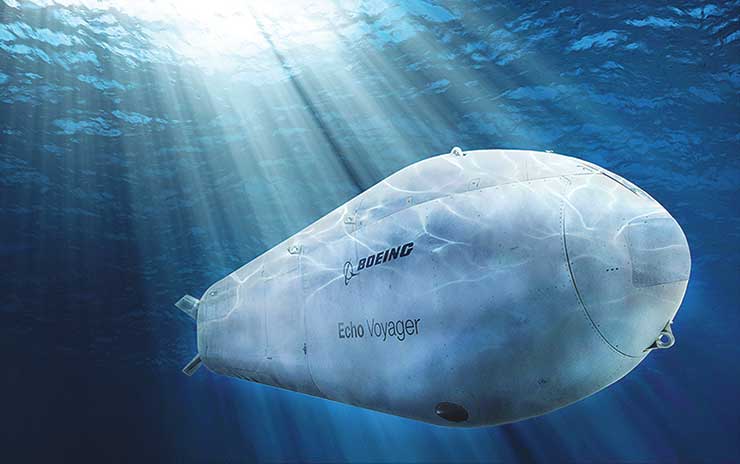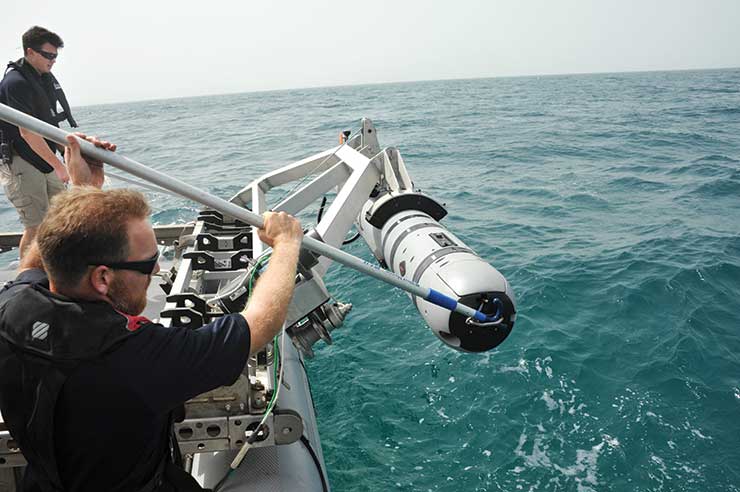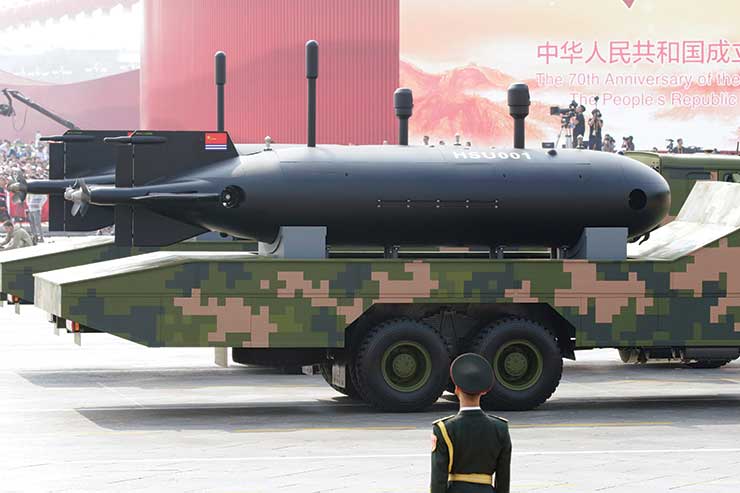
In November 2021, during the Naval Commanders Conference, Defence Minister Rajnath Singh released the Indian Navy’s Unmanned Roadmap. It was a classified document, so very little was known of its contents. An unclassified version, released by the Prime Minister in August 2022 at the Indian Navy’s annual Swavlamban conference, was expected to provide the industry with a clear direction for developing these unmanned technologies. With the current focus on indigenisation, this document was made available to only a few selected Indian firms. Hence, there is still a lack of adequate information on the Indian Navy’s unmanned roadmap plans in the open domain.
Unmanned technologies in the air have been around for over two decades. They have also captured the public imagination – their ubiquitous presence at marriage functions, as delivery vehicles for pizzas and groceries, and their coordinated glitzy displays at events, including the venerable Beating the Retreat in New Delhi, has spawned a whole industry of drone manufacturers. However, the technologies involved in military applications are far more sophisticated, and still available in only a few countries. This is nowhere more so than in the undersea domain, which presents a far more challenging environment, and it is here that the military dimension of unmanned technologies will soon be most evident.
The importance of unmanned underwater technologies in maritime security needs no emphasis and has been repeatedly flagged as the next big thing by naval leadership across the world, including successive Chiefs of the Indian Navy.
Navies around the world are investing considerable time, effort and resources in developing their unmanned capabilities, be it in the air, on the surface or below the surface; there is no doubt that their importance as effective force multipliers in a variety of kinetic and non-kinetic applications is going to increase exponentially.
The development of unmanned underwater technologies is not restricted to military applications alone; autonomous underwater vehicles (AUV) and Remotely Operated Vehicles (ROV) are being used extensively in civilian applications for seabed mapping, sub-bottom profiling, laying, maintaining and repairing of submarine cables, and oil and gas pipelines, geological and hydrographic research and various other applications.
The US Navy has recently inducted its first XLUUV called Orca. The US XLUUV programme commenced over a decade ago (in 2012) with Boeing developing its ‘Echo Voyager’ as a proof-of-concept. It is arguably the most advanced UUV in the world
The introduction of unmanned underwater technologies into the military domain is comparatively recent. Besides its deployment in traditional warfare scenarios, it is now becoming a weapon of choice in grey zone warfare, and most alarmingly, this sophisticated technology, which is still beyond the scope of many countries, is now becoming available to non-state actors through their state sponsors. In the ongoing West Asian crisis, the Houthi attacks on shipping in the Red Sea and the Bab-el-Mandeb have gone from missile and airborne drone attacks to underwater drones, which has triggered serious alarm because of the limited ability to interdict and neutralise them.
Unmanned Underwater Vehicles, or UUVs as they are more commonly referred to, include a wide range of platforms and capabilities. At its most basic level, ‘smart torpedoes‘ and pre-programmed mines are two examples of unmanned underwater technologies that have been in use by navies for many decades, to the extent that they are no longer even considered UUVs. The SeaHake Mod 4 ER (Extended Range) Heavyweight torpedo developed by the German firm Atlas Elektronik has a range of about 150 km (which is three times that of any other contemporary torpedo in the world) and once fired, proceeds to its target through a series of pre-planned waypoints, while periodically updating its position through GPS. It has no communication with the firing platform and is autonomous in the true sense of the term.
Modern developments in unmanned underwater technologies are focussed on three important aspects; firstly, in minimising the human element by taking the man out of the loop and away from direct kinetic action; secondly, as effective force multipliers, where they can support large and expensive manned platforms with cheaper unmanned options capable of performing roles and missions underwater at a much lower cost, while submarines can focus on their primary warfighting role; and thirdly, deploying these in various configurations with flexible payloads to get a better understanding and awareness of the underwater domain, and operating in conjunction with existing sensors on manned platforms to enhance maritime situational awareness.

UUVs are being developed for a range of roles and missions ranging from extra-large UUVs (XLUUV), armed and equipped with weapons and sensors for surveillance of large ocean areas to small ROVs mounted with an explosive charge being used as dispensable fire-and-forget options to detonate mines etc. The US Navy has recently inducted its first XLUUV called Orca. The US XLUUV programme commenced over a decade ago (in 2012) with Boeing developing its ‘Echo Voyager’ as a proof-of-concept. It is arguably the most advanced UUV in the world. With a displacement of 85 tonnes and a length of over 25 metres, it can carry a 34-tonne payload and remain submerged for over 15 days.
XLUUVs are presently at various stages of development with most of the world’s leading navies, and will add the much-needed flexibility of movement over fixed seabed sensors like the SOSUS which monitored the movement of Soviet submarines through the Greenland Iceland-UK (GIUK) Gap during the Cold War or the more recent ‘Fish Hook’ system extending from Japan to Sumatra.
XLUUVs are in various stages of development in most modern navies. The UK is developing the 12-metre-long CETUS which is expected to be ready in two years. France has ordered an XLUUV demonstrator. Canada has begun sea trials of its Solus- XR XLUUV. South Korea is developing an MRXUUV (Mission Reconfigurable Extra Large Unmanned Underwater Vehicle) system and expects it to be operational by 2027. Japan showcased its ‘Long endurance, multi-role UUV research prototype at the DSEI in Tokyo in 2023. Israel showcased its Blue Whale XLUUV at the UDT Conference in 2023.
While XLUUVs are meant for independent long-endurance missions, there are a wide range of smaller medium-sized UUVs with reconfigurable multi-mission payloads capable of effective mine countermeasure, shallow water operations, Intelligence, surveillance and reconnaissance (ISR) missions, electronic warfare, hydrographic survey and other undersea tasks in the littorals where undetected submarine deployment is a challenge.
The US has developed the REMUS 620, based on the very successful REMUS 300 small UUV programme, and is probably amongst the most advanced in the world at present. It has a battery endurance of about 110 hours and a range of about 275 nautical miles and can be launched from submarines, small unmanned surface craft, larger surface platforms and also from helicopters. UUVs can also be launched from larger UUVs. Fitted with synthetic aperture sonars, these medium-sized UUVs offer unmatched capability in underwater detection and tracking and greatly assist the commander’s decision-making in an operational theatre. The REMUS is not unique.
The maritime tension constantly simmering in the Indo-Pacific with China’s Grey Zone strategy gives cause for concern. China has focused a lot of attention on strengthening its undersea warfare capability in recent years
Many large and medium navies are focussing attention on developing this capability with a mission suite tailored to their requirements. They also include LDUUVs like Kongsberg’s HUGIN family or the US Sharkfish amongst others. LDUUVs and Medium UUVs provide the capability for IPOE (Intelligence Preparation of the Operational Environment) and Seabed Warfare (SBW). Medium and small UUVs like the REMUS 620 can be launched simultaneously from different platforms for the same mission.
The maritime tension constantly simmering in the Indo-Pacific with China’s Grey Zone strategy gives cause for concern. China has focused a lot of attention on strengthening its undersea warfare capability in recent years. The monitoring of the undersea domain and enhancing its underwater domain awareness (UDA) is critical to its submarine deployments in its ‘far abroad. The recovery of a Chinese underwater glider by Indonesia in the Sea of Natuna a few years ago dispelled any doubt about China’s intentions to monitor undersea maritime activity in the region. The frequent deployment of its research vessels in the eastern Indian Ocean and now moving further westward to the Maldives is in line with its stated intent of expanding its naval footprint in the Indian Ocean. Underwater gliders launched from these research vessels collect valuable undersea data which can then be analysed and disseminated.
In the next decade or so, the presence of a few Chinese nuclear attack submarines (SSN) in the Indian Ocean complemented by an unmanned presence is an inevitability if it intends to contain the Indian Navy, and make a bid for maritime domination of this critical sea space. A knowledge of what lies below the surface in the Indian Ocean and the hydrological profile of its waters will greatly assist the deployment of Chinese submarines besides its other economic interests in exploiting the Indian Ocean for economic and strategic gain.

China’s unmanned programme has been under wraps but satellite imagery has shown that the development of XLUUVs is very much in progress. Based on its HSU-001 LDUUV which was first seen in public in 2019, this one seems much larger and could be similar in size and capability to the US Navy’s ORCA. Chinese unmanned ambitions also extend to using unmanned surface vessels for undersea roles and missions. In 2020, it conducted a ‘National Intelligent Unmanned Ship Search Competition’ which aligns with its Civil-Military Fusion (CMF) Strategy of harnessing cutting-edge disruptive technologies simultaneously for civil and military applications, towards achieving its national strategic objectives.
The advantages and multi-mission capabilities of unmanned underwater vehicles as effective force multipliers are leading to a rapid acceleration in their research, development, design and construction across the world. Navies are constantly demanding improvements in range, endurance and autonomous capabilities for addressing the wide spectrum of emerging traditional and non-traditional maritime security challenges. For example, the US Office of Naval Research is exploring ‘Next-Generation Autonomous Underwater Vehicle Sensors and Capabilities’ to further enhance its Subsea Warfare, Seabed Warfare and other undersea warfare capabilities and has awarded three prototype contracts to leading US firms for accelerated and cost-effective development of these.
UUVs are well suited for IPOE (Intelligence Preparation of the Operational Environment). By using their sensors to collect hydrological and operational information about a particular area in advance of submarine deployment, they enable submarines to operate safely and improve their situational and domain awareness for high-risk operations including special operations in shallow waters.
The advantages and multi-mission capabilities of unmanned underwater vehicles as effective force multipliers are leading to a rapid acceleration in their research, development, design and construction across the world. Navies are constantly demanding improvements in range, endurance and autonomous capabilities for addressing the wide spectrum of emerging traditional and non-traditional maritime security challenges
The Indian programme to develop unmanned underwater technologies has all stakeholders working on developing different platforms, both in the civilian as well as the military domain. The MoD has focussed its attention on the development of XLUUVs and has articulated a requirement of 12, while also initiating a programme for HEAUVs (High Endurance Autonomous Underwater Vehicles) capable of performing a host of tasks with an ability to not only be launched from a submarine but also recovering it on board. In addition to these, there is a lot of cutting-edge development work being undertaken in the public and private sectors, academia and research institutions towards maturing these technologies into capabilities.
UUVs are set to alter the nature of undersea warfare whether in detecting, tracking or attacking undersea, surface, or land targets. Such missions will require new and advanced capabilities, from seamless, real-time communications among UUVs and manned platforms to advanced undersea navigation and real-time data transfer in a multi-static networked battlespace. As this technology develops, the focus will be on manoeuvrability, endurance, size, multi-mission capability, weapons and sensors including towed array sonars.
–The writer is a veteran Indian Navy officer and Vice President, Indian Maritime Foundation. The views expressed are of the writer and do not necessarily reflect the views of Raksha Anirveda















